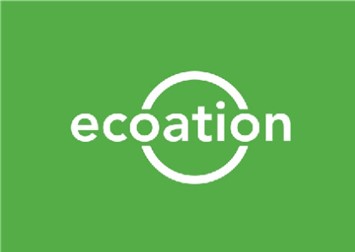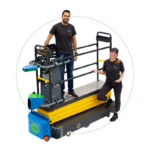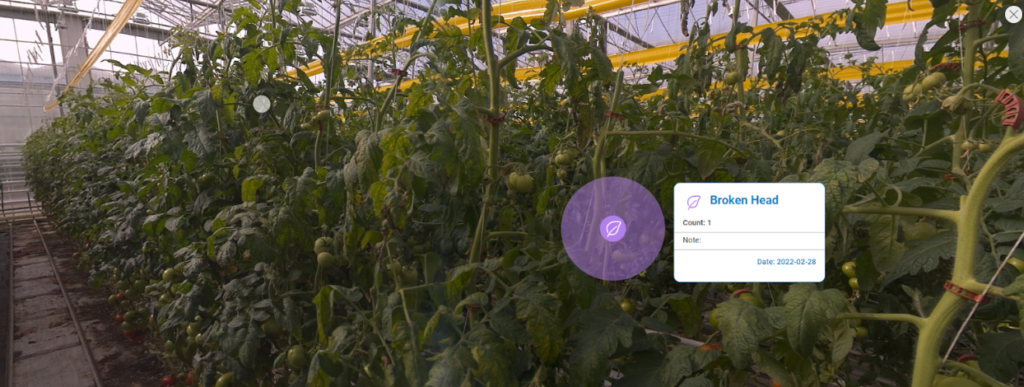
Integrated Pest Management (IPM) Software Platform
The Virtual walk for IPM Managers

Our IPM software platform provides a comprehensive virtual walk of the Greenhouse that meticulously photographs the growing area, post by post. The detailed photographs are analyzed by AI to give you a comprehensive birds eye-view of your plant’s health, disease pressure and crop count.
What is IPM?
Integrated Pest Management (IPM) is a holistic approach to pest control that aims to minimize the reliance on chemical pesticides and maximize the use of environmentally friendly strategies.
IPM emphasizes prevention as the first line of defense against pests. It starts with regular monitoring and identification of pests, followed by setting action thresholds to determine when intervention is necessary. The next step involves implementing a combination of cultural, biological, and mechanical control methods to manage pests. These methods may include crop rotation, habitat manipulation, biological control agents, such as predators and parasites, and physical barriers.
Chemical pesticides are used as a last resort and are carefully selected and applied based on their efficacy and minimal impact on non-target organisms. When pesticides are used, IPM focuses on targeted applications, using lower amounts and choosing the least toxic options available. Additionally, IPM encourages the use of alternative pest control methods, such as pheromone traps, insect growth regulators, and botanical insecticides.
One of the key principles of IPM is education and awareness. Farmers, gardeners, and pest control professionals are encouraged to understand the biology and behavior of pests, as well as the ecological balance of their environment. By having this knowledge, they can make informed decisions and implement appropriate pest management strategies effectively.
Overall, integrated pest management promotes a sustainable and balanced approach to pest control by minimizing the use of chemical pesticides, reducing the development of pesticide resistance, protecting beneficial organisms, and safeguarding the environment for future generations.
Why should I use IPM Software?
Using software for Integrated Pest Management (IPM) offers several advantages that can enhance the effectiveness and efficiency of pest control efforts. Some of these advantages include:
Data Management:
 Software allows for the systematic collection, organization, and analysis of data related to pest monitoring, infestations, and control measures. It provides a centralized platform for recording and storing information, such as pest sightings, trap captures, and pesticide applications. This data can be easily accessed, reviewed, and used to make informed pest management decisions.
Software allows for the systematic collection, organization, and analysis of data related to pest monitoring, infestations, and control measures. It provides a centralized platform for recording and storing information, such as pest sightings, trap captures, and pesticide applications. This data can be easily accessed, reviewed, and used to make informed pest management decisions.Real-time Monitoring: Many software solutions offer real-time monitoring capabilities, allowing users to track pest populations and environmental conditions continuously. This enables timely intervention when pest thresholds are reached or when environmental factors favor pest outbreaks. Real-time monitoring can help prevent large-scale infestations and reduce the need for reactive treatments.
Decision Support: Software can provide decision support tools based on collected data, pest biology, and established thresholds. These tools can assist in determining the most appropriate and effective control strategies for specific pests. By providing recommendations and guidance, software helps users make well-informed decisions, resulting in targeted and efficient pest management practices.
Communication and Collaboration:
 Software facilitates effective communication and collaboration among stakeholders involved in IPM, such as farmers, pest control professionals, and researchers. It allows for easy sharing of data, pest observations, and treatment histories, promoting collaboration, knowledge exchange, and coordinated pest management efforts. This enhances the overall effectiveness of IPM programs.
Software facilitates effective communication and collaboration among stakeholders involved in IPM, such as farmers, pest control professionals, and researchers. It allows for easy sharing of data, pest observations, and treatment histories, promoting collaboration, knowledge exchange, and coordinated pest management efforts. This enhances the overall effectiveness of IPM programs.Reporting and Documentation: Software streamlines the process of generating reports and documenting pest management activities. It simplifies the creation of comprehensive reports that include pest trends, control strategies implemented, and their outcomes. This documentation is valuable for regulatory compliance, auditing purposes, and demonstrating adherence to IPM protocols.
Historical Analysis and Trend Identification: By storing and organizing data over time, software enables the analysis of historical trends in pest populations, control measures, and their effectiveness. This analysis can help identify patterns, make predictions, and improve long-term pest management strategies. It also facilitates the evaluation of IPM program success and the identification of areas for improvement.
In summary, software for Integrated Pest Management offers advantages such as streamlined data management, real-time monitoring, decision support, improved communication and collaboration, efficient reporting and documentation, and the ability to analyze historical trends. These benefits contribute to more effective and sustainable pest control practices while reducing the reliance on chemical pesticides.
How does IPM work with OKO?
OKO is a powerful tool that helps greenhouse growers with their IPM efforts. By using OKO while scouting, the location information is automatically detected and the scout can spend 100% of their attention on pest and disease identification. The easy-to-use interface on the OKO also helps the scout to enter their observations into the system. OKO is also equipped with a guidebook that helps train the scouts on the go. The information from the scout, as well as environmental info, and a high-resolution picture, is uploaded to the cloud automatically, providing growers with real-time information and analytics.
What makes OKOs better than IPM app?
There can be several factors that make OKOs better than other IPM apps, depending on the specific features and capabilities of each app. However, some of the key
advantages that OKOs offer compared to other IPM apps include:
Improved efficiency for scouts
The automation of the monitoring process and the use of advanced technology reduces the time and effort required for IPM. This allows scouts to work up to 25% more efficiently and effectively.
Real-time data analytics for IPM Managers
While the scouts use the OKO, all collected data, including environmental information and images, are automatically uploaded to the cloud. An ecoation AI engine analyzes the trends and sends a notification to IPM managers and decision makers when needed.
Generating IPM forecast maps
Most scouts only visit 20-30% of the greenhouse every week. OKO uses an AI model to process the information gathered from the scouts, and the environmental conditions, to provide a real-time IPM forecast. This information can then be used by growers to make informed decisions about pest control, as well as prevent and manage outbreaks before they occur. For example, if the IPM forecast map indicates a high risk of pest outbreak in a specific area, the grower can take action to treat that area and prevent the outbreak from spreading. The ability to generate IPM forecast maps in real-time and identify potential pest outbreaks early is a key advantage of OKO over traditional scouting methods and apps in the market. It helps growers to stay ahead of the curve and make proactive decisions about their pest control, ultimately improving yields and maximizing profits.
Lower costs for IPM
By automating the monitoring process and reducing the risk of human error, OKOs can help to lower the costs associated with IPM. The data from growers using the system for more than one season indicates significant cost savings.
How much ROI can I expect from OKO IPM?
The OKO IPM module allows growers to quickly respond to pest outbreaks, reducing the negative impact on their crops and maximizing yields. With OKO, greenhouse scouts can become “super scouts” by being equipped with the latest technology and information. This enables them to work more efficiently and effectively to keep their plants healthy and productive. Large-scale commercial greenhouses that were previously using pen and paper typically see an ROI of 2.5x on their IPM efforts.
Who owns the Greenhouse Data collected by OKO?
You own all of the data collected and stored by OKO and ecoation from your Greenhouse. You have complete control and access to the collected data through our interface. We only store the data for the purposes that have been agreed upon as part of our Digitized Scouting, Integrated Pest Management and Yield Forecasting program.
Effective IPM strategy for the Greenhouse
Integrated Pest Management (IPM) has become a successful method in greenhouse farming, serving to uphold plant well-being and reduce reliance on harmful pesticides. Through the integration of preventive and control techniques, an IPM strategy strives to manage pests, diseases, and weeds, all while fostering a sustainable and eco-friendly cultivation setting. We collaborate closely with our greenhouse growers at ecoation, supporting them in the implementation of a sustainable and prosperous IPM strategy.
